Case Study 007

Client:

Area Size:
5.5ha
Timeline:
9 Days
Product:
EnviroSoil
WBHO Industrial Soil Stabilisation
Soil Stabilisation
Find out how we did it

Client:

Area Size:
5.5ha
Timeline:
9 Days
Product:
EnviroSoil
Find out how we did it
WBHO Industrial Soil Stabilisation
In early 2019 WBHO, approached Erizon to undertake 5.5 hectares of soil stabilisation and revegetation works for a major highway upgrade, on Old Cooma’s Road, within the Queanbeyan regional council area, located south-east of New South Wales. During the upgrade road works had disturbed the substrate upon cutting into the land and therefore the soil required investigation within the designatedvegetation plots. Based on an independent soil analysis of the site, results confirmed that the soil present was ingenuin subsoil material which would not be conducive for revegetation purposes. Due to the unavailability of active topsoil, Erizon would be required to propose a solution to support the clients’ revegetation objectives for the roadside cuttings and field batters while meeting the Road and Maritime Service (RMS) specifications.
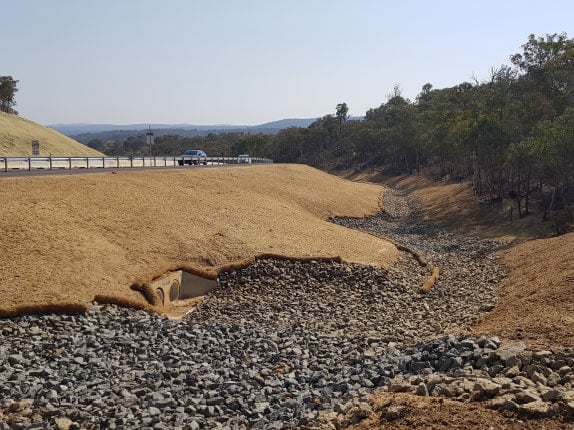
Scroll to see more
WBHO Industrial Soil Stabilisation
In early May, Erizon’s environmental consultants met with WBHO personnel to inspect the location and conduct a 3-dimensional drone survey for a thorough examination of the land topography and determine the amount of product required to cover the substrate area.
Given the soil disturbance and lack of appropriate topsoil storage, Erizon was concerned with the condition of the remaining soil and therefore conducted a soil analysis which revealed the following results:
+ Both exchangeable and soluble magnesium were extraordinarily high, which resulted in low calcium and potassium. This imbalance was likely to have a significant effect on nutrient availability to plants and have an impact on the soils physical characteristics.
+ Phosphorus, nitrogen and potassium were low in all samples.
+ All trace elements except iron were deficient.
+ Organic matter was deplorable.
Based on the comprehensive assessment of the site in conjunction with the soil results, Erizon put forward a framework that articulated WBHO’s industry commitment to meet the relevant RMS standards and requirements for the road embankment and roadside cutting stabilisation. The following recommendation consisted of agricultural additives to underpin soil stabilisation and vegetation growth:
+ Enviro Soil – hydraulic biotic soil amendment
+ Native seeds blend
+ AgCalcium Boost
+ Custom fertiliser - Di-Ammonium Phosphate (DAP)
+ EnviroLoc - Hydromulching Bonded Fibre Matrix (BFM)
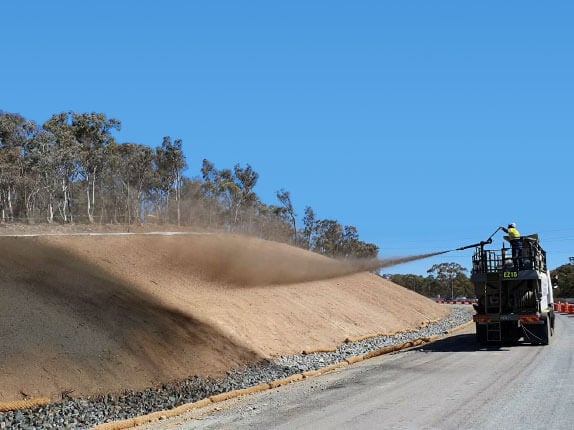
Scroll to see more
WBHO Industrial Soil Stabilisation
Given the lack of microbial activity and nutrient deficiencies found in the soil, calcium, EnviroSoil, fertilisers and hydromulch were implemented into the soil stabilisation and rehabilitation program.
1. Calcium: In support of Enviro Soil, the AgCalcium Boost would be applied first and designed to help breakdown the soil properties and enhance the active botanicals in the soil.
2. EnviroSoil: The foundation of the proposed solution would be a hydraulic topsoil alternative applied to depleted soil for revegetation support. With eight active components, it can revive lifeless soils and facilitate germination and establishment in severe conditions.
3. Fertiliser: Nitrogen, phosphorus, potassium, sulphur and additional trace elements were required to balance the soil deficiencies.
4. Hydromulch: The mulch fibres display hygroscopic properties, therefore delivering up to 50% more water holding capacity which displaces optimal water filtration around the seed. The mulch also provides a protective erosion control cover which assists in maintaining optimal temperature, water filtration for optimal seed germination and help suppress weed growth.
Equipment:
The equipment used on this project was one of Erizon’s fully mine compliant HydroTrucks. The management of the hydraulic cannon provided the technicians with the flexibility to adjust pressure rates for application consistency and uniform delivery. The internal agitators located within the holding tank consistently mixed the products to ensure an even application onto the designated substrate.
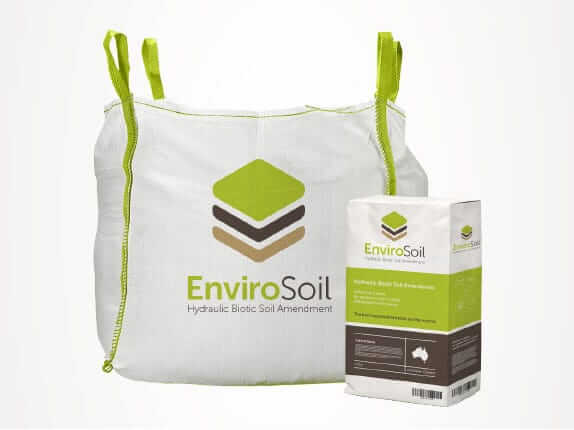
Scroll to see more
WBHO Industrial Soil Stabilisation
Works commenced with an initial 3-dimensional drone survey which recorded and mapped the area to a high degree of accuracy. Accompanied by an analysis of the site conditions and soil characteristics, a scientifically tailored remediation program was developed and consisted of a three-phase process to align with the client's goals and objectives.
Phase 1:
The first hydraulic application of the areas would consist of a highly available calcium solution applied to the subsoil at rates that gave an equivalent response to broadcasting 4-5tonnes/ha of Ag Lime. The calcium, properties would change the soil profile by rendering it susceptible to breaking down and would assist in the second phase of the program by supporting the active botanicals in the EnviroSoil.
Phase 2:
The second pass consisted of the hydraulic application of Envirosoil, combined with the specified fertilisers and RMS specifications approved native seed blend for an optimal growing environment.
Phase 3:
The final treatment phase included the EnviroLoc hydromulching solution, along with binders and supportive fertilisers.
In support of these three phases, the team worked in collaboration with the team at WBHO, to assist them with a supplementary irrigation plan. The recommendations provided were suggested in line with the local climate conditions to ensure the best vegetation outcome for the project.
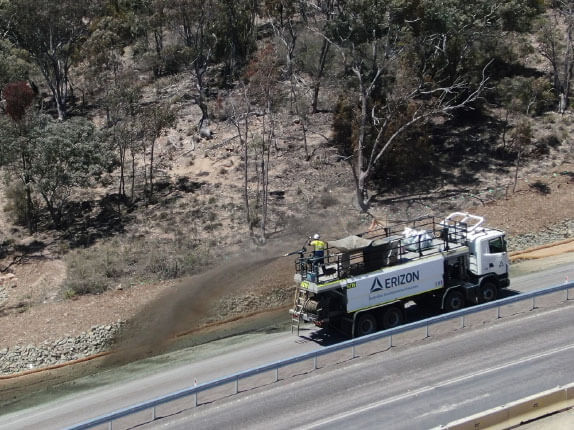
Scroll to see more
WBHO Industrial Soil Stabilisation
Erizon encountered multiple problems throughout theduration of the project; however, these were addressed promptly to ensure that project schedules were maintained.
Location:
The team were required to maintain duties while working in and around the existing plant, equipment and contractors completing earthworks within the same area - this approach was successful as a result of positive communication with the client and their
personnel.
Weather:
Warm temperatures averaging 27 °C accompanied by high winds, required strategic planning of application to eliminate the possibility of overspray and loss of product.
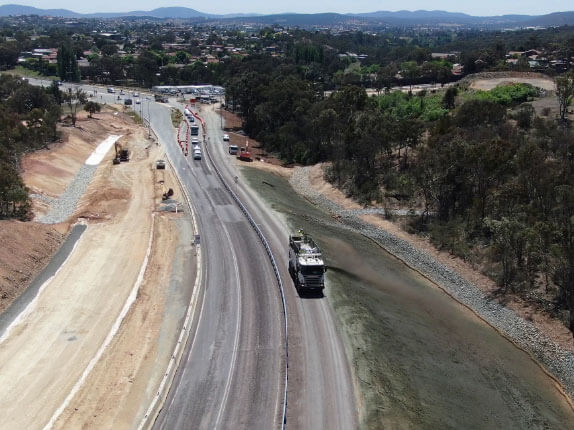
Scroll to see more
WBHO Industrial Soil Stabilisation
After the final sign of with WBHO, the feedback implied that the client was impressed with the coverage, application and the engagement with the team as a whole. The results to date have some signs of agricultural growth, which had formed within the first month, post-application.
This partnership will continue, with full results anticipated during a site review in early March of 2020.
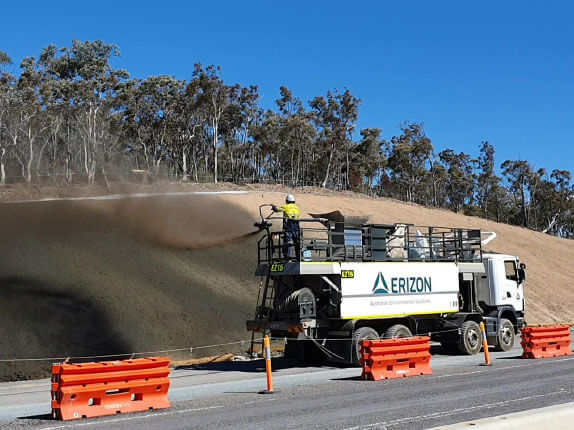
Scroll to see more
Enquire
Tell us about your project and get the best possible advice from our experts
Download
Download a PDF of this case study
Newsletter
Get the latest industry news as it happens